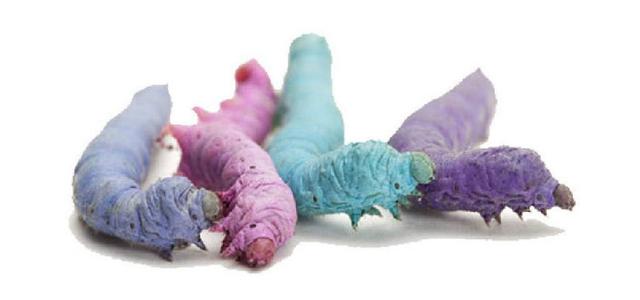Silkworms, particularly their colorful varieties, are often admired for their bright hues and unique appearance. However, there are many questions surrounding whether these silkworm babies are poisonous or harmful to humans and pets. In this article, we will delve into the question of "Are colorful silkworm babies poisonous?" by exploring their biology, behavior, and the potential risks they pose. We’ll provide an in-depth answer to give you peace of mind when handling these fascinating creatures.

Silkworms (Bombyx mori) are well-known for their role in silk production, but some species of silkworms are more colorful than others. The term "colorful silkworm babies" typically refers to the larvae of these silkworms that display vibrant colors such as green, yellow, red, or even blue, depending on the species. These color variations are often a result of genetic mutations or differences in diet and environmental conditions.
The larval stage of a silkworm is when it feeds voraciously and grows rapidly before undergoing metamorphosis into a pupa and eventually emerging as an adult moth. These baby silkworms, despite their striking appearance, have very specific needs for care and feeding, especially if they are being raised for silk production or as pets.
One of the most common questions about colorful silkworm babies is whether they are poisonous or toxic to humans or pets. The short answer is: no, colorful silkworm larvae are not poisonous. Unlike some other caterpillar species that produce toxins as a defense mechanism, silkworm larvae do not pose a threat to human health through direct contact.
Here’s a deeper look into why silkworm babies are safe to handle:
Silkworms, both the larvae and adult moths, do not produce any toxic substances or venom that would cause harm to humans or animals. Their primary defense mechanism against predators is camouflage and blending into their environment, rather than relying on toxins. While some caterpillars and larvae (like the Lonomia caterpillar) possess venomous spines, silkworm larvae do not have any stinging or venomous properties.
Silkworms are herbivores and typically feed on mulberry leaves. This diet is completely safe for humans and animals. There are no harmful chemicals in the silkworm larvae themselves, provided they are raised in clean environments free from pesticides and toxins. However, like any insect, if you are handling them, it is always advisable to wash your hands afterward to prevent any potential allergens or irritants from transferring.
Silkworm larvae do not carry diseases that are transmissible to humans or pets. They are typically farmed in controlled environments where hygiene and safety standards are maintained to prevent any risks of contamination. As long as proper care is taken when handling silkworms, such as maintaining hygiene and ensuring a clean habitat, they pose no health risks.
While colorful silkworm babies are not poisonous, it is still important to follow safety precautions to ensure both the health of the silkworms and the safety of humans or pets interacting with them:
Avoid Ingesting Silkworms
Even though silkworm larvae are not toxic, they should never be eaten by humans or animals. If you are keeping silkworms as pets or in an educational environment, make sure they are not ingested. Some cultures, however, do consume silkworm pupae in culinary dishes, but these are cooked and prepared properly to ensure they are safe for consumption.
Wash Hands After Handling
Whenever you handle silkworms, wash your hands thoroughly afterward, especially if you are working with multiple silkworms or touching their environment. This helps reduce the risk of transferring allergens or irritants to your skin or mouth.
Keep Silkworms in a Safe Environment
If you are raising silkworms, ensure that their environment is clean and free of harmful chemicals. Pesticides or unregulated diets can lead to health issues for the silkworms and could indirectly affect their safety. Always source silkworms from trusted suppliers if you are unsure about their upbringing.
| Characteristic | Colorful Silkworm Babies | Toxic Caterpillars |
|---|---|---|
| Venomous/Poisonous | No, not venomous or poisonous | Yes, some species have venomous spines or toxic fluids (e.g., Lonomia caterpillar) |
| Main Defense Mechanism | Camouflage, blending into the environment | Venom, stinging spines, or irritants |
| Diet | Herbivores, primarily feeding on mulberry leaves | Varies by species; some may eat toxic plants |
| Health Risks to Humans/Pets | None, as long as proper handling is maintained | Potential for severe allergic reactions or poisoning |
| Common Use in Pet Trade or Education | Yes, commonly kept as pets or in educational settings | Not typically kept as pets due to toxicity |
In conclusion, you can confidently enjoy observing and caring for colorful silkworm babies without the concern of toxicity. Just follow basic safety and hygiene protocols to ensure a safe and healthy interaction.
In summary, colorful silkworm babies are completely non-toxic and are safe to handle. These fascinating larvae, which display a variety of vibrant colors, do not produce venom or harmful substances that would pose a threat to humans or pets. However, basic hygiene precautions should be followed when handling them, and it is essential to ensure they are raised in a safe and clean environment.
By understanding their biology and the potential risks associated with handling silkworms, you can enjoy observing these incredible creatures without worrying about toxicity.
animal tags: Bombycidae
We created this article in conjunction with AI technology, then made sure it was fact-checked and edited by a Animals Top editor.